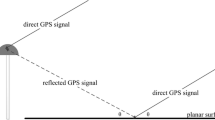Abstract
A solar-powered GPS receiver has been installed near Beaver Lake, Antarctica, to monitor postglacial isostatic rebound that may be occurring as a result of ice thinning near the Lambert Glacier since the last glacial maximum. The equipment is 400 km from the nearest Australian Antarctic base and is completely automated. It is expected that there will be sufficient solar power to operate the equipment from January 1998 to May 1998, but the data will not be recovered until the following summer season. The scatter in height computed from the first 25 days of data is ± 7.5 mm. If such precision is representative of the accuracy of the height estimates, isostatic rebound of < 1 mm/yr will be able to be detected after a few years of observations at the site. © 1999 John Wiley & Sons, Inc.
Similar content being viewed by others
Author information
Authors and Affiliations
Rights and permissions
About this article
Cite this article
Tregoning, P., Twilley, B., Hendy, M. et al. Monitoring Isostatic Rebound in Antarctica with the Use of Continuous Remote GPS Observations. GPS Solutions 2, 70–75 (1999). https://doi.org/10.1007/PL00012759
Published:
Issue Date:
DOI: https://doi.org/10.1007/PL00012759



